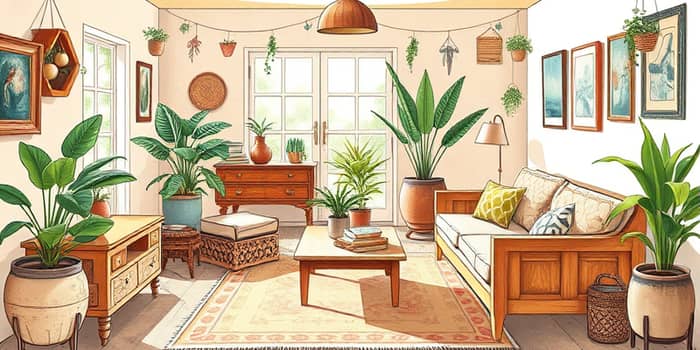In an age of fleeting trends and mass-produced furnishings, it is easy to feel trapped in an endless cycle of buying and discarding. Fast decor, driven by social media and constant micro-trends, has led many of us to fill our homes with items that lack meaning and longevity. But there is another path: one of intention, purpose, and deep personal connection.
Understanding the Rise and Fall of Fast Decor
Fast decor refers to the rapid consumption and turnover of trendy items, often made from low-quality materials that expire within months. The 1960s saw Americans send an average of 2.5 million tons of furniture to landfills each year; by 2018 that figure had skyrocketed to 10 million tons, according to the US EPA. Between 2019 and 2021, furniture sales surged by $4 billion, much of which will likely end up as waste within a few years.
- Mass-produced designs sold at rock-bottom prices
- Short-lived styles driven by social media trends
- Little to no emotional or functional value
- High environmental cost and carbon footprint
In the era of micro-trends, what is fashionable today can feel outdated by tomorrow. Social media platforms amplify this effect, offering a constant stream of perfectly styled interiors that leaves many feeling compelled to refresh their own spaces weekly. This relentless pace not only burdens our wallets but also frays our sense of identity, as we chase external approval rather than authentic self-expression.
The cultural phenomenon of fast decor reflects broader patterns of impulsive consumption. Driven by convenience and the allure of novelty, we too often prioritize speed over substance, resulting in homes that feel transient and uninspiring. Yet, by recognizing these forces, we gain the power to resist them.
The Philosophy of Intentional Design
Intentional design, often called slow decorating, encourages homeowners to pause and reflect before selecting each piece. It focuses on fewer, well-crafted, durable pieces chosen for their function, beauty, and personal significance. Instead of impulsively embracing whatever is “in,” this philosophy asks: What do I need? What brings me joy? How can my space support my well-being?
At its core, intentional design is about spaces that reflect personal stories. It is a deliberate, mindful process that values quality over quantity and sustainability over waste. Every object earns its place, contributing to an atmosphere of harmony and purpose.
Central to this philosophy is the belief that every object should have a story and purpose. Whether it’s a handcrafted chair passed down through generations or a bespoke piece commissioned from a local artisan, each selection fosters a deeper emotional bond. This approach also encourages collaboration with craftspeople, strengthening communities and preserving traditional skills.
Intentional design values process as much as the end result, inviting homeowners to engage with their spaces over time. It’s about creating meaningful environments that nurture mind and soul, not just assembling furniture according to a checklist.
Benefits of Slow Decorating
Adopting a slow decorating mindset offers a wealth of advantages:
- Improved emotional well-being: Homes designed with care can reduce stress and increase comfort.
- Long-term financial savings: Investing in high-quality pieces means fewer repurchases and repairs.
- Less environmental impact: Choosing sustainable, reclaimed, or locally made items cuts down on waste.
- Authentic self-expression: A curated space tells your unique story, free from cookie-cutter styles.
By selecting pieces that resonate personally, each room becomes a sanctuary rather than just a showcase of the latest fad.
Fast Decor vs Intentional Design: A Comparison
This side-by-side highlights why embracing intentional design can transform not only our homes, but also our lives and the planet.
Steps to Embrace Intentional Design
Transitioning from fast decor to a more mindful approach might seem daunting, but it starts with small, purposeful actions:
- Take your time: Allow rooms to evolve naturally; avoid pressure to finish projects quickly.
- Ask meaningful questions: Does this piece serve a purpose or bring joy?
- Prioritize craftsmanship: Seek out artisan, vintage, or locally made furnishings.
- Embrace versatility: Choose items that can adapt to different uses or settings.
- Curate with care: Display heirlooms, personal artworks, and travel mementos.
- Focus on function: Arrange layouts based on actual daily routines.
Additionally, create a mood board or digital collection of inspiration before shopping, and set a clear budget to avoid impulsive buys. Planning helps you build a cohesive vision and make empowered choices.
Cultivating a Culture of Mindful Consumption
By choosing intentional design, you join a growing movement that values craftsmanship, sustainability, and authenticity. Each piece in your home becomes a conversation starter, a reminder of thoughtful selection and emotional connection. This shift can inspire friends, family, and neighbors to reconsider their own decorating habits, creating ripples that extend far beyond individual living rooms.
Nurturing a Home That Grows with You
Intentional design isn’t about creating static displays; it’s about fostering living, breathing environments that adapt to your changing needs. A room might begin with a simple sofa and evolve as you discover vintage lighting at a local market. Over time, each addition tells part of your story.
This approach encourages patience and reflection. It reminds us that homes should serve as supportive backdrops for life’s moments—quiet mornings with coffee, gatherings with loved ones, creative pursuits, and seasons of rest and renewal.
Conclusion: Building a Legacy Through Design
Fast decor promises instant gratification, but often delivers fleeting satisfaction and long-term waste. Intentional design asks us to slow down, invest deeply, and choose boldly. It honors the past, sustains the present, and lays foundations for the future.
When you bid farewell to the relentless churn of trends and embrace thoughtful curation, your home transforms into more than a living space—it becomes a legacy of values, memories, and beauty that endures. Start today by looking around and asking which items truly belong, and which deserve to be set free.
In doing so, you not only enrich your daily life but also contribute to a more sustainable world, where every piece in your home has heart, history, and meaning.
References
- https://wellbydesign.com/blogs/blog/intentional-home-design-the-importance-of-slow-creation
- https://www.whisperingbold.com/post/intentional-design-is-key-to-creating-meaningful-spaces
- https://www.astekhome.com/blogs/news/3-ways-to-improve-well-being-with-intentional-design
- https://www.holistichavens.com/2023/05/02/the-benefits-of-an-intentional-home/
- https://www.intentionaldesign.co/blog/what-exactly-is-intentional-design
- https://architizer.com/blog/inspiration/stories/fast-furniture-micro-trends-consumer-culture-destroying-good-design/
- https://www.drip.com/blog/email-subject-lines
- https://shopmeraki.co/fr-eu/blogs/journal-fr/slow-decorating-embracing-intentional-and-sustainable-interior-design-in-2025










